9 best AI meeting assistants in 2025
Explore the best AI meeting assistants with key features, pricing, tips for smooth implementation, and important limitations to note.
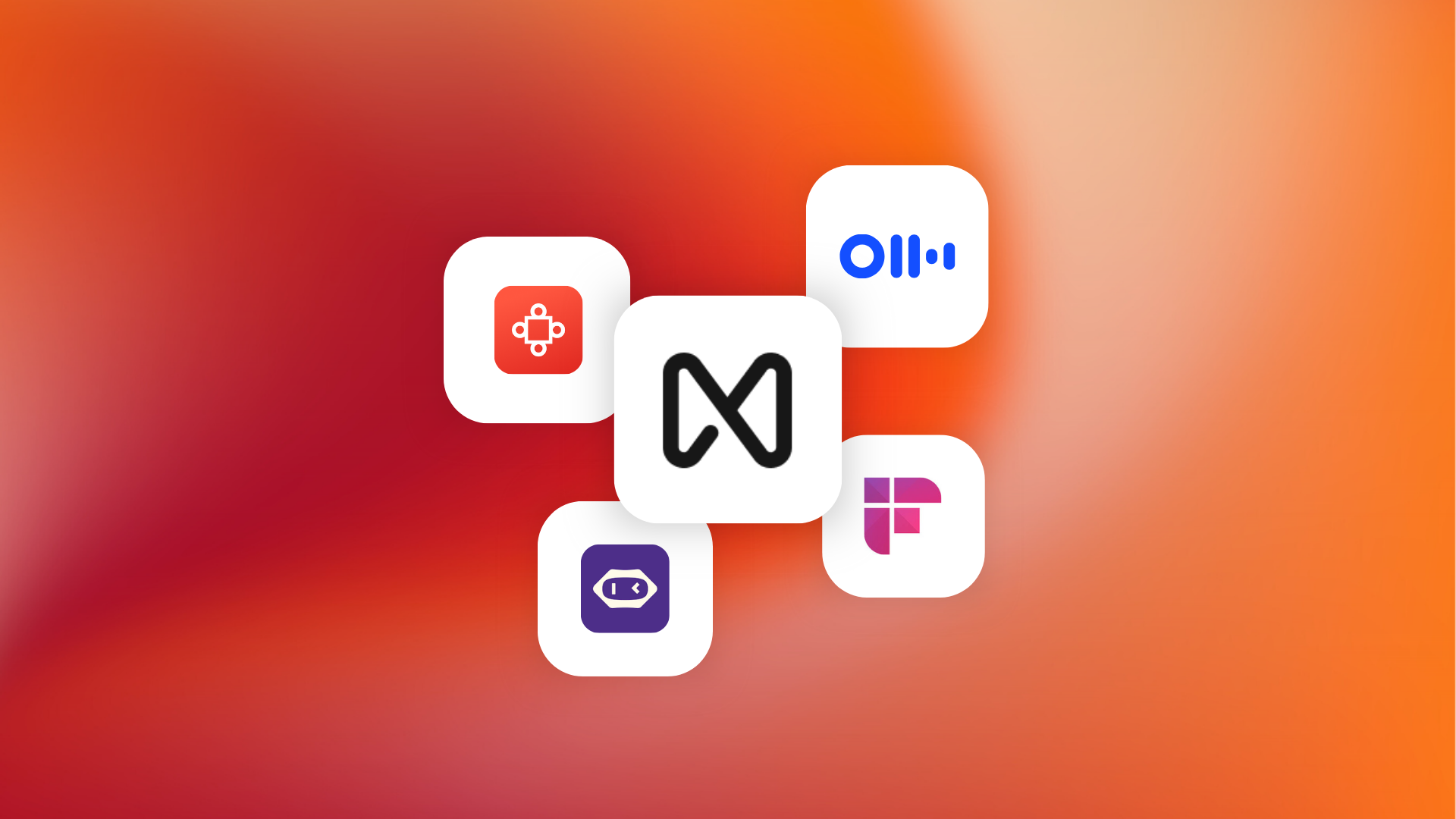
Meetings are where decisions are made and where notes get lost. If your team still spends precious hours reshaping meeting notes, chasing action items, or replaying recordings to find one quote, an AI meeting assistant can change your work life.
These tools join calls, transcribe speech, highlight decisions, and, increasingly, summarize insights, create follow-ups, and plug work back into your CRM or project tools.
In this guide, we have rounded up the best AI meeting assistants. Let’s dive in.
Top AI note taker for Teams: Comparison table
| Tool | Best for | Free plan? | Standout strength |
| Metanotes AI | AI meeting notetaker | Yes | Focuses on minimal friction capture, concise summaries, and seamless meeting note management |
| Otter | Team transcription & editing | Yes | Mature collaboration workspace. |
| Fireflies | Automation + integrations | Yes | Workflow automations & API. |
| Fathom | Fast summaries, free-friendly | Yes | Simple, fast summaries. |
| Avoma | Conversation analytics | Yes / trial | Coaching + CRM automation. |
| MeetGeek | Affordable team transcription | Yes | Value-priced storage & search. |
| Sembly | Structured summaries | Yes | Project-level meeting organization. |
| Grain | Sales highlights & clips | Yes | Shareable clips and account insights. |
| Tactiq | Browser/Google Meet users | Yes | Quick, browser-first transcripts. |
9 best AI meeting assistants
Discover nine standout AI tools that automatically record, transcribe, and summarize meetings, helping teams capture key decisions and action items with minimal effort.
1. Metanotes AI

Metanotes is a free AI meeting note taker. It captures live discussions across multiple platforms and organises every conversation. It’s an AI note taker for Zoom, Google Meet, or Teams, delivering clean transcripts and concise summaries so you can focus on the dialogue instead of note-taking.
Features
- Accurate live transcription with clear speaker labels
- Instant AI summaries outlining key decisions and action points
- Automatic topic tagging and keyword search for quick reference
- Built-in sentiment and trend analysis for deeper insights
- Easy export and integrations with tools like Slack, Notion, and calendars
Pricing
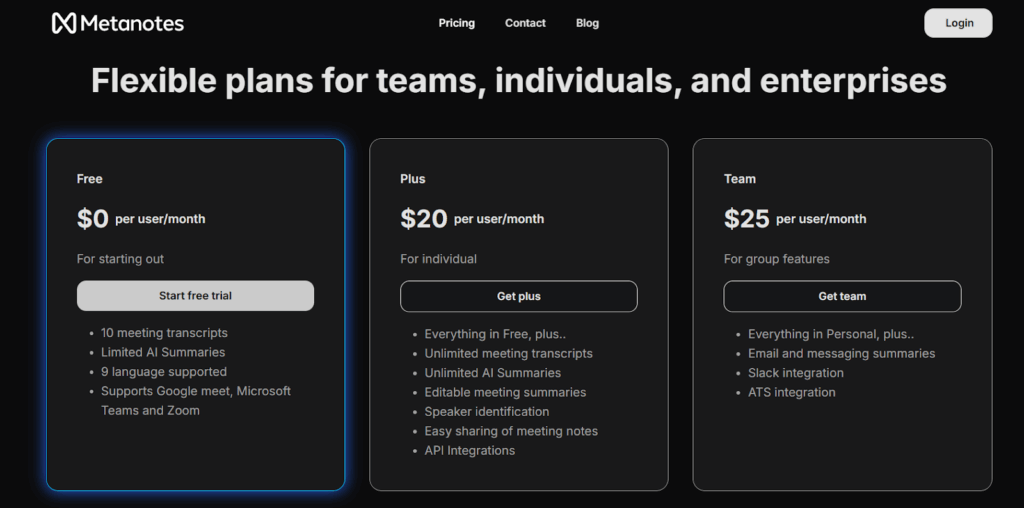
2. Otter
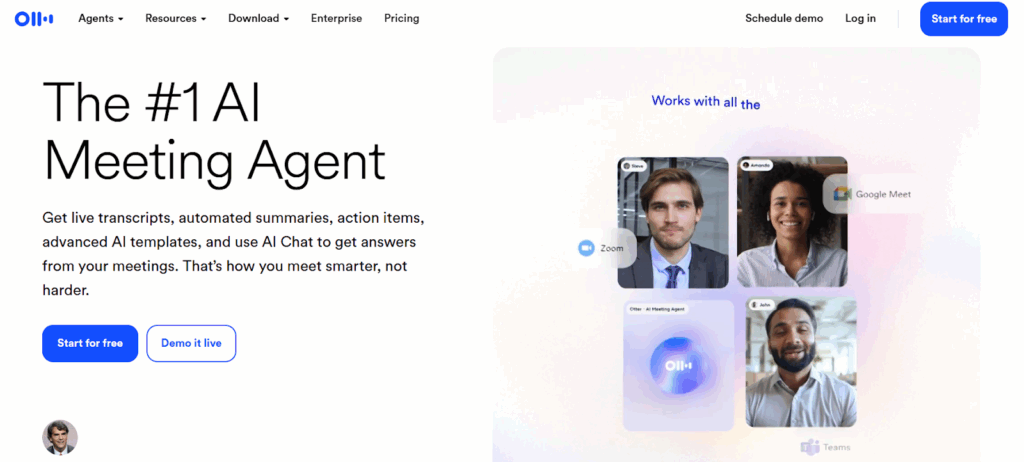
Otter is one of the longest-running transcription and meeting-note tools. It’s used by teams for live meeting transcription, searchable meeting archives, and collaborative notes. Otter is strong at real-time capture and offers simple collaboration features for teams that want meeting text to be a living document.
Key features
- Real-time transcription for Zoom, Teams, Google Meet and in-person audio
- Auto-highlights and speaker identification
- Shared team workspaces and editable meeting notes.
- Import audio/video files for transcription and export in multiple formats
- Mobile app for on-the-go capture (in-person interviews, calls).
Pricing
Free plan available; paid tiers for power users. Typical Pro pricing shown on Otter’s site is around $8.33/user/month (annual) or higher for monthly billing and business tiers, check Otter for current details.
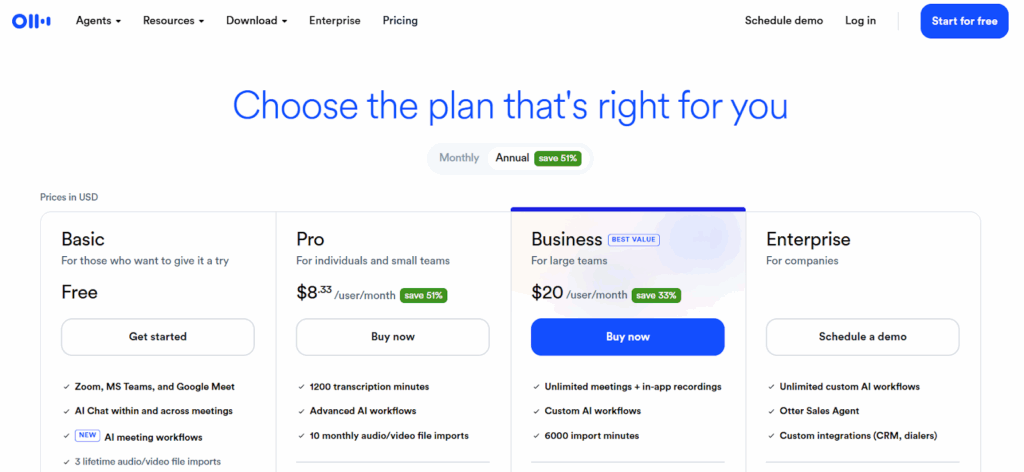
3. Fireflies

Fireflies joins meetings (or ingests recordings), transcribes them, and layers AI summaries, searchable transcripts, and workflow automations such as follow-up emails or CRM updates. It’s widely chosen by teams that want a meeting pipeline that plugs into Slack, CRMs, and cloud storage.
Key features
- Automated meeting joiner bot and unlimited transcription on paid plans
- AI-generated meeting summaries and action items.
- Integrations: Slack, Salesforce, HubSpot, Google Drive, Zoom.
- Searchable transcript repository with keyword search.
- API access and developer tools for custom workflows.
Pricing
Free tier available. Paid plans typically start around $10–$18/user/month with business/enterprise tiers for more controls and compliance. Always confirm current pricing on Fireflies’ pricing page.

4. Fathom

Fathom focuses on being a “set-and-forget” meeting assistant: join your Zoom calls, record, and get short, accurate transcripts and summaries delivered quickly. Many users like Fathom for its simplicity and the quality of its short summaries and action extraction.
Key features
- One-click recording and automatic transcription for Zoom.
- Instant summaries and action items emailed or available in the app.
- Easy clipping and sharing of important moments.
- Focus on privacy: simple controls for what’s stored/shared.
- Free tier that’s useful for individuals and small teams.
Pricing
Fathom offers a usable free tier; paid plans add storage and team features. Check Fathom for the latest plan details.
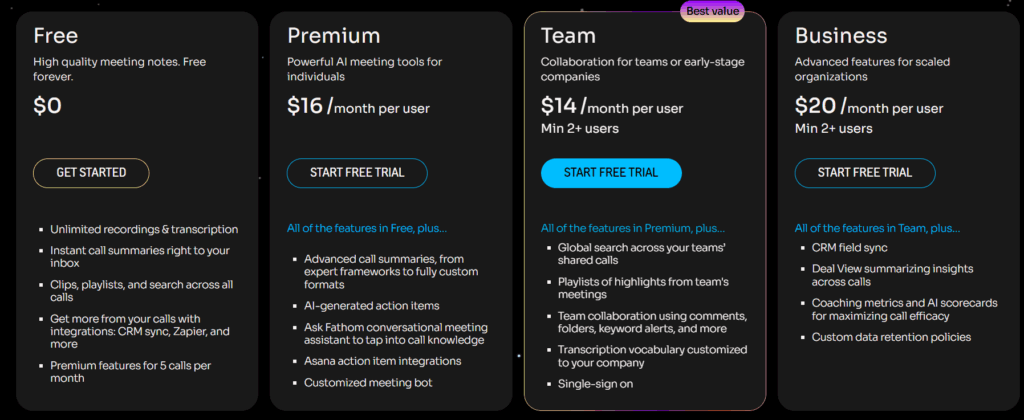
5. Avoma
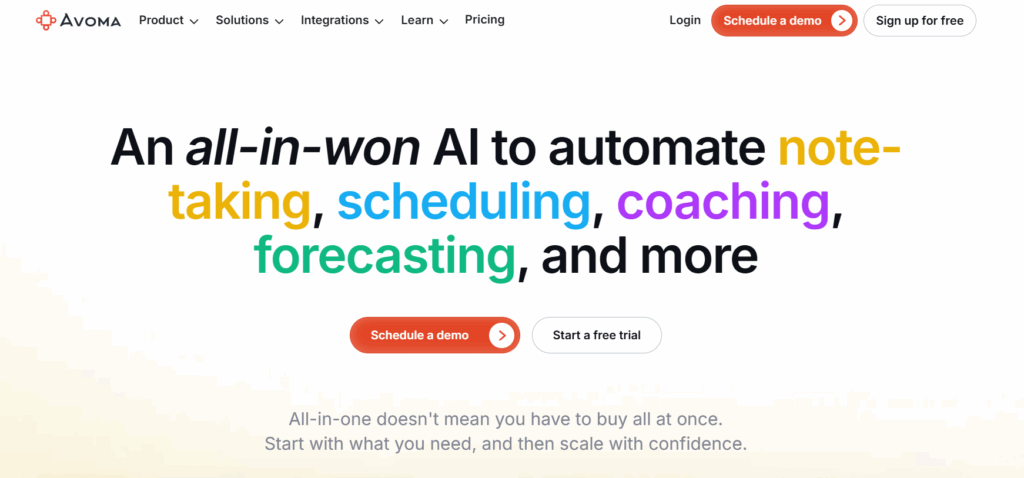
Avoma combines meeting transcription with conversation analytics and workflow automation. It’s built for teams that need coaching insights, speaker analytics, and automatic CRM updates, particularly sales, support, and customer-success teams.
Key features
- Automated note-taking with AI-summaries and action items.
- Conversation analytics (talk-time, topics, coaching cues).
- CRM integrations and auto-updates (HubSpot, Salesforce, etc.).
- Collaborative playbooks and meeting templates for consistent calls.
- Workflow automations for follow-ups and tasks.
Pricing
Avoma commonly lists a free trial and paid plans around $19/user/month (annual) for full AI meeting assistant capabilities, enterprises get custom pricing. Verify current pricing on Avoma’s site.
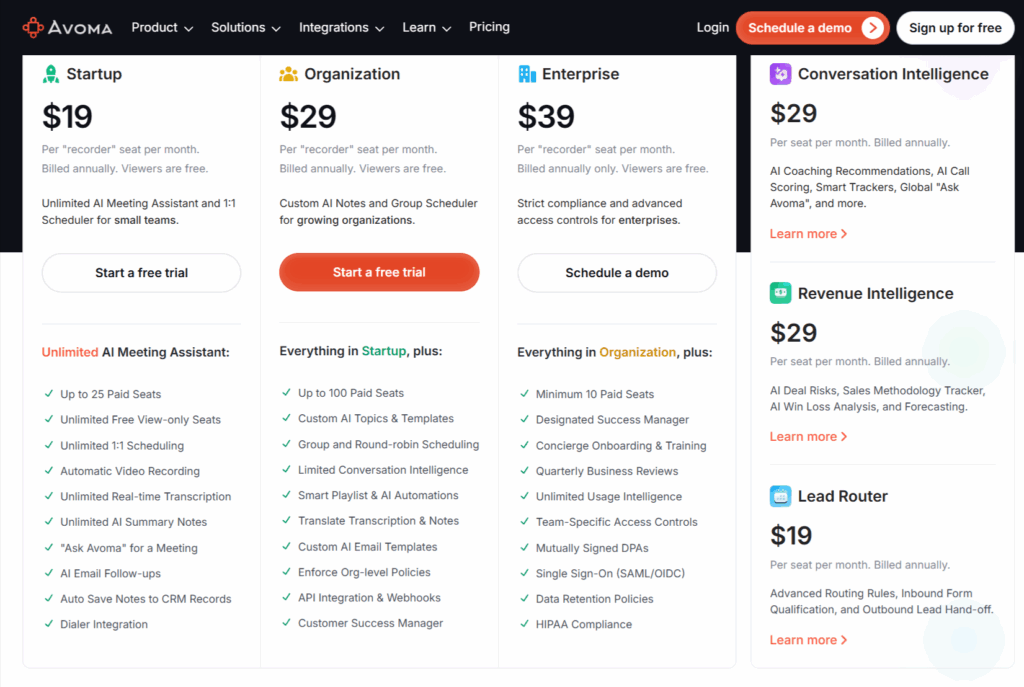
6. MeetGeek

MeetGeek provides straightforward meeting transcription, summaries, searchable archives, and integrations, all with a strong value-for-money angle. Good for teams that want a clean record of meetings and simple actions.
Key features
- Automated recording and transcription of calls.
- AI-generated highlights, summary and action items.
- Team library with search across meetings.
- Integrations with calendars, Slack, and cloud drives.
- Pricing designed for small teams, with free and paid tiers.
Pricing
MeetGeek has a free plan and paid plans that begin with modest monthly fees (they promote discounts for annual billing). Check MeetGeek’s pricing page for up-to-date options.
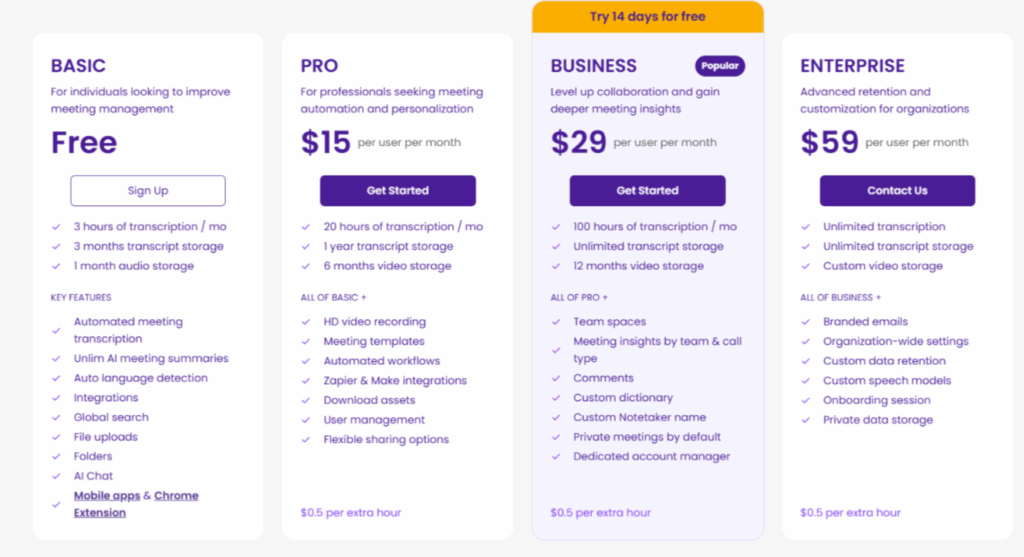
7. Sembly

Sembly is an all-round meeting assistant that emphasizes structured minutes, collections (grouped meetings), and project-level organization. It works well for teams that want meeting notes to be actionable and easy to pass to project management systems.
Key features
- Auto-join and record meetings across Zoom, Meet, Teams.
- Smart meeting summaries and minutes exported to team tools.
- Collections to group related meetings (projects, clients).
- Templates and pre-saved workflows to speed up sharing.
- Zapier and native integrations for automation.
Pricing
Sembly offers free trials and affordable tiers depending on storage and seat counts; see Sembly’s site for current pricing tiers.
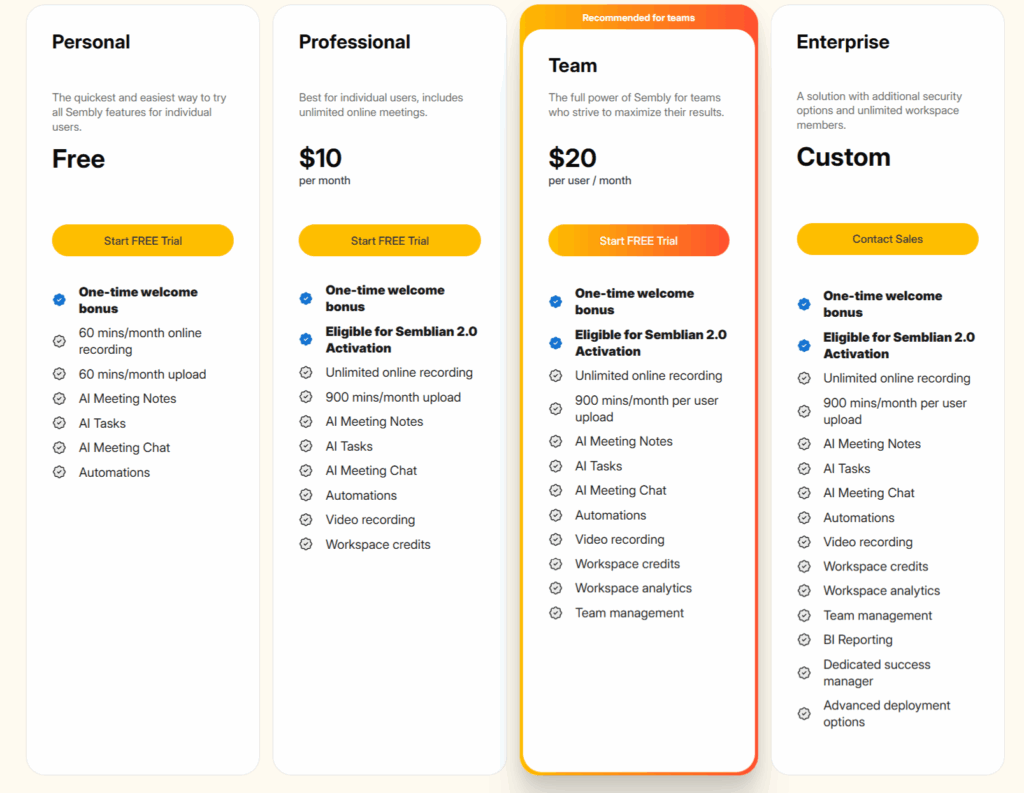
8. Grain

Grain is built for teams that need polished meeting highlights and short clips, especially sales and customer success teams who want to pull shareable moments for decks, training, or stakeholder updates. It captures, highlights, and syncs insights into CRMs and Slack.
Key features
- Capture meeting highlights and create shareable clips.
- Export clips and transcripts into CRM (HubSpot, Salesforce).
- Cross-meeting search and account-level insights.
- Coaching and performance dashboards for sales teams.
- Free starter tier with paid plans for unlimited recording and advanced features.
Pricing
Grain offers a free plan; paid plans commonly start around $15–$19/user/month (annual billed). Check Grain’s pricing page for latest offers.
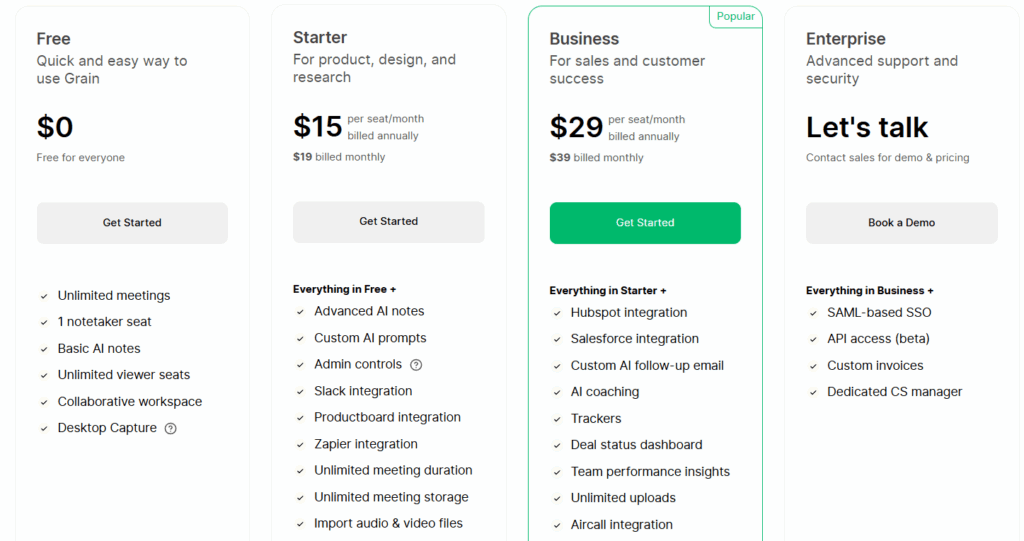
9. Tactiq
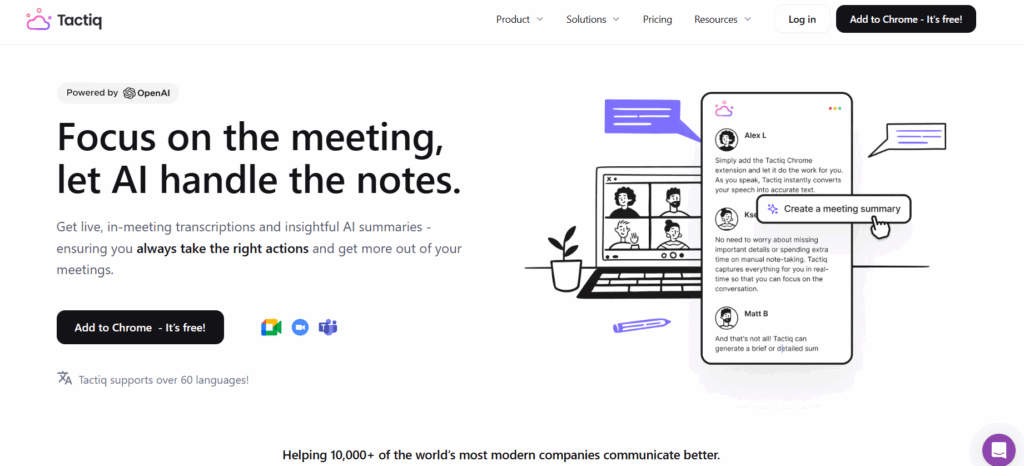
Tactiq is a browser-first extension that captures live transcripts in Google Meet (and other web calls) and quickly creates summaries, action items, and formatted outputs (Jira, Markdown, etc.). For people who work heavily inside Google Meet or the browser, Tactiq is a low-friction option.
Key features
- Live transcription overlay in Google Meet and other browser-based meetings.
- AI summaries, action items, and export to Jira/Notion/Markdown.
- Quick keyboard shortcuts to capture moments.
- Team sharing and searchable transcript storage.
- Free tier is useful; paid plans add AI credits and team spaces.
Pricing
Free tier exists; paid plans typically start in the $8–$12/user/month range (annual billing discounted). Confirm current pricing on Tactiq’s pricing page.

Privacy, compliance, and security for meeting assistants
When you invite a bot into a meeting or upload recordings, you’re sharing potentially sensitive information. Here’s what to check before rolling any assistant out to employees:
Where are recordings stored?
Check where your meeting data is physically stored and how long it’s kept. Ensure the vendor offers clear data-residency options and retention policies that match your company’s requirements. Many enterprise plans provide custom storage locations or automatic deletion schedules, review the platform’s security or compliance pages before signing up.
Who can access transcripts?
Confirm that only authorized team members can view or edit transcripts. Look for granular, role-based permissions, single sign-on (SSO), and audit logs so administrators can track access. These controls prevent accidental sharing of sensitive information and give you confidence that private meeting details remain secure inside the platform.
Compliance needs
If your organization must meet regulations like SOC 2, GDPR, HIPAA, or ISO 27001, verify the assistant’s certifications and compliance features. Ask for documentation or third-party audit reports and check whether enterprise plans include data-processing agreements and breach-notification protocols to help your company stay aligned with industry and legal standards.
Participant consent
Always inform everyone on the call that it will be recorded and transcribed. This is not just a courtesy, it’s a legal requirement in many jurisdictions. Share a brief statement at the start of each meeting or use automated pre-meeting notices so participants can give explicit consent before the session begins.
Meeting assistant implementation tips
Practical steps to roll out an AI meeting assistant smoothly, from pilot testing to training and measuring impact, so your team gets maximum value quickly.
Start with a pilot
Begin by testing the AI assistant with one department, such as sales, product, or operations, for about 4–6 weeks. Track how much time is saved on note-taking and whether action items are more accurate. A focused pilot helps you evaluate real benefits and gather user feedback before rolling out company-wide.
Define retention rules
Establish clear guidelines for how long transcripts and recordings are kept. Set automatic deletion schedules for data you don’t need to retain, and document these policies so everyone understands them. Proactive retention rules protect privacy, meet compliance standards, and prevent unnecessary storage Pricings as your library of meetings grows.
Create templates
Use pre-built meeting templates or custom AI prompts to maintain consistent summaries, action items, and follow-ups across teams. Tools like Avoma and Sembly include ready-made templates that standardize note-taking and speed up report generation, ensuring every meeting, whether sales or product, follows a clear, repeatable documentation process for easy review later.
Train your team
Provide quick training materials or brief workshops that show employees how to highlight key moments, correct transcription errors, and export clips to tools like Slack or Notion. Platforms such as Grain and tl;dv are simple to use, but a short orientation accelerates adoption and helps everyone get the most value.
Measure impact
Monitor key metrics like time spent on post-meeting administration, number of action items completed, and meeting ROI (decisions or tasks generated per meeting). Where possible, use built-in conversation analytics to gather data. Regular measurement shows whether the AI assistant truly boosts productivity and informs decisions about scaling its use.
Shortcomings to be aware of when using meeting assistants
Understand the common limitations of AI meeting tools, including transcription accuracy, changing features, and the need for human oversight on critical discussions.
Transcription accuracy varies
AI meeting assistants can struggle with diverse accents, poor audio quality, or industry-specific terminology. Background noise, overlapping voices, or weak internet connections also reduce accuracy.
For important discussions, such as legal, financial, or technical meetings, plan to review and edit transcripts or add a human verification step to ensure quotes and key details remain precise.
Feature drift
Software platforms evolve quickly: vendors frequently add, retire, or reorganize features and pricing tiers. A capability you rely on today, like unlimited storage or a specific integration, might move to a higher plan or disappear altogether. Before large-scale deployment, review current pricing, feature lists, and enterprise terms to avoid surprises or unexpected costs.
Overreliance on AI summaries
AI-generated summaries are great for speed but can overlook subtle context, emotional tone, or nuanced decisions made during a discussion. Treat them as a productivity booster, not a final record.
For critical meetings, such as strategic planning or legal negotiations, have a team member review, refine, and approve summaries to maintain accuracy and accountability.
Final thoughts
From accurate real-time transcription to automated summaries, action items, and seamless integrations, AI meeting assistants can save hours of manual work and keep projects moving.
When choosing the right assistant, match the tool to your team’s priorities, whether that’s reliable collaboration, advanced analytics, or quick highlight creation. Start with a small pilot, set clear data policies, and involve your team in training and feedback.
Used thoughtfully, an AI meeting assistant isn’t just a recorder; it’s a silent teammate that helps everyone stay focused on decisions and next steps while ensuring nothing important is lost.